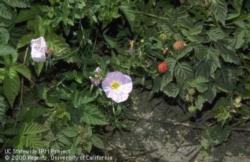Weed Management
What is a weed anyway? Well, a weed is defined as "a plant growing out of place, where it is not wanted." With that said, is a wild blackberry growing in your flower bed a weed? The answer might be "yes" depending on your point of view.
There are many disadvantages of having weeds:
- They compete with other plants for space, nutrients, water, and sunlight.
- They can serve as hosts for insect pests and pathogens.
- They provide cover or food for vertebrate pests such as mice.
- They cause allergies for many people. Pollen is the culprit of some weeds, while the foliage of other weeds such as poison oak can cause allergic reactions on the skin.
On the up-side, there are some advantages to having weeds:
- They reduce dust and soil erosion.
- They provide cover and food for vertebrates such as birds.
- They are a source of nectar for honeybees, bumblebees, and hummingbirds.
- They are a habitat for beneficial predator or parasite insects.
- They can be a source of additional soil organic matter when they decompose.
- They are a potential source or therapeutic pharmaceuticals.

Primrose infested by wild blackberry, Rubus sp.
Weeds can fall into one of 3 life cycle categories:
- Annual-weeds that complete their life cycle from seed to seed in one year or less. They grow, set seed, and die out completely. Only new plants are those germinated from seed and appear the following year. Examples of annual weeds are groundsel, mallow, pigweed, and purslane.
- Biennial-weeds that complete their life cycle in 2 years. During the first year, they produce leaves, stems, and a root system. The cold winter that follows this vegetative growth will help initiate flower development. In the spring and summer of the second year, the weeds will flower, set seed, and die. Examples of biennial weeds are mullein, sherpherd's purse, and bristly oxtongue.
- Perennial-weeds that live longer than 2 years and usually have a more extensive root system that the other two life cycles. Examples of perennial weeds are nutsedge, bindweeds, oxalis, and poison oak.
